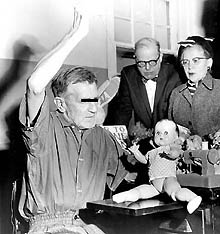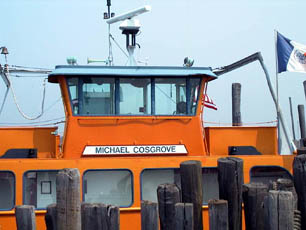| Hart Island -- Part 2: Reformatory, Homeless Men, Phoenix House
Brush fires of 1903 and 1904 destroyed the wooden markers designating gravesites. This brought to light the need for something more permanent, and stone markers have since been used. The numbers on the markers correspond to a detailed record of vital statistics of the deceased.

|
|
Concrete marker designates numbered gravesite. Each gravesite holds 150 adult coffins. Each coffin's exact location is recorded on a chart for that numbered gravesite.
|
The record books contain 400 pages and last about six months before another one has to be started. With approximately 800,000 interments in Potter's Field, the records are now somewhat voluminous.
A "Reformatory for Misdemeanants" was created in 1905 and it was generally referred to as the reformatory for vicious boys. It was later relocated to another part of the island to prevent association with the older prisoners.
During World War II, Hart Island became home for German prisoners of war. After the war, ten acres at the northern end of the island were taken over by the U.S. Army for a Nike missile base as part of the defense system of New York City. They abandoned the site on June 30, 1961.
The inmates on the island who spent long hours digging grave petitioned for permission to build a monument for those interred on the island. With permission granted, both prisoners and staff cooperated to create a thirty-foot memorial in 1948.

|
|
The Hart Island memorial monument some decades ago.
|
The word "peace" is inscribed on one side and a simple cross on the other. There is no Star of David as the Jewish Free Burial Society takes care of their own. Catholics [once] had consecrated ground for interment but in 1960 two Catholic Societies began following the example of their Jewish brethren. It should be noted, however, that religion can rarely be established.
The Board of Estimate authorized the use of the island for the rehabilitation of about 2,000 homeless men in 1950 and the wintertime population burgeoned. The men loved it there and would not think twice about breaking a window at the first frost to be transported back to the heated facilities provided for them on Hart Island. Matt Dillon and Danny Glover starred in an interesting film entitled "The Saint of Fort Washington." It's a story about a homeless man who is killed and interred on Hart Island and has some local footage.
The Department of Correction resumed control of the island in 1954 and it was generally used for minor offenders. These men often used the same tactics as the homeless to regain admission to the island.

|
|
Warden Edward Dros and Correction Commissioner Anna M. Kross observe elderly inmate sew a doll at Hart Island shop repairing toys for needy children.
|
Ed Dros, who joined the Department of Correction in 1928, served on Hart Island for many years, supervising the burial of approximately 8,000 people a year and the disinterment of approximately 150 remains a year. He had indicated in a New York Daily News interview of 1967 that about thirty younger prisoners were assigned to the burial detail and were paid fifty cents a day. He further indicated that there was always a waiting list of about 50 volunteers to take their place as kitchen helpers were paid only two cents a day.
The sizes of the burial trenches varied over the years and most recently were approximately 15'x4O' and seven to eight feet deep. The simple rough pine coffins that are first waterproofed and identified are stacked three deep . . . . The coffins are delivered by the city morgue and transported from the Fordham Street dock on City Island by ferry. The frequency of the deliveries has varied over the years and two ferries in use were the Fordham and the Michael Cosgrove. The Fordham was an old coal stoker built in 1922 by Kyle & Purdy. The 190-ton vessel had dimensions of 84x26xlO and was out of documentation in 1982. The Michael Cosgrove, powered by two diesel engines, was built in 1961 by Blount Marine in Warren, Rhode Island. This 139-ton ferry-boat measures 60x35x9.
A New York Times article of 1967 by Clayton Knowles indicated that the ferries were costing the city in excess of $300,000 a year and the Lindsay administration was planning to curb their use. At the time the vessels were operating 24 hours a day, seven days a week. They required six captains, twenty deck hands, seven marine engineers and seven stokers. Needless to say, they remained in operation for sometime thereafter.

|
|
NYC Dept. of Transportation runs the ferry.
|
The Penal Code was altered in 1966 forcing the close of the Hart Island prison and the following year the Office of Narcotics Administration utilized the facilities for the rehabilitation of drug addicts. They spent $3 million to create Phoenix House which thrived until 1976 when the high costs of operating the ferry caused it to close.
. The residents of Phoenix House grew their own vegetables, held concerts and organized ball games against various outside teams including City Island, the Department of Correction and even NBC. They also published their own newsletter. It was first called The Phoenix but was shortly changed to Hart Beat. The paper featured stories about their various activities including barbecues, picnics, lectures and visits by friends. One frequent visitor was the popular Father Egan, sometimes known as the junkie priest for his extensive work with narcotic users. They also built themselves a gym and turned the old warden's house into a library. Reformed addicts who spent time at their Hart Island facility still tell stories of the tears and laughter that filled their days of recovery.
Many institutions and people have come to Hart Island and left, only the bodies of the destitute remain along with those who bury the dead. The poor will always be with us as will Potter's Field where the dead reign supreme. What hope hath man if not faith!
|






